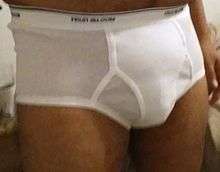Briefs
Briefs are a type of short, snug underwear and swimwear, as opposed to styles where material extends down the thighs.
Briefs have various different styles, usually with a waistband attached to fabric that runs along the pelvis to the crotch and buttocks, and are worn by both men and women. Swim briefs are a variation used as swimwear.[1][2]
History
Classic briefs were first sold on January 19, 1935, by Coopers, Inc., in Chicago, Illinois, at Marshall Field's department store. They dubbed the new undergarment the "Jockey", because it offered a similar degree of support as the jockstrap (one style of which is also called jock brief or support briefs). The designer of the new style was reportedly inspired by a postcard he had received from a friend visiting the French Riviera depicting a man in a very short, form-fitting bathing suit. 30,000 pairs were sold within three months of their introduction.[3]
In North America, "jockey shorts" or "jockeys" became an often used generic term for men's briefs. More recently, "tighty-whiteys" has become a commonly used slang term for such briefs.[4][5]
In the UK, briefs were first sold in 1938.[6] Soon, shops were selling 3,000 pairs of briefs per week. They were so popular that in 1948, every member of the British Olympic team was given a free pair of briefs.
In the UK, the term "jockeys" has not caught on and briefs are often referred to as "Y-fronts". The term derives from the genericized trademark "Y-Front", property of Jockey International.[7] It in turn derives from the inverted Y-shape formed by the seams at the front of the underpants.[8] The colloquialism is used even when the fly opening may differ in style, and not actually form the shape of the inverted letter "Y" fly on Coopers/Jockey brand briefs.
In Australia, briefs are referred to as "jocks" but should not be confused with jockstraps (more specifically used by athletes) which expose the buttocks. Australians generally use the word “briefs” to refer to the bikini-style underwear for men, which do not have the Y-front opening.
Since the end of the 20th century, a hybrid called boxer briefs has become popular. Like boxers, they have short legs, but like briefs, they are made of elastic, snug-fitting material. A shorter version of boxer briefs are called trunk briefs.
Design
Traditional size briefs for both sexes cover the upper part of the thigh and extend upward up to (or cover, depending on the design) the navel at the waistband. This style is often referred to as "full rise" or "full cut". There are also "low rise" and "mid rise" styles whose measurements vary between manufacturers.
Men's briefs often feature a fly—a covered opening on the front of the garment which allows for convenience in urinating. There are several different fly designs in common use, including the standard vertical fly, the horizontal fly, the Y-front fly, and others. The use of a fly is optional, and many styles do not utilize a fly at all.
Men's briefs

In the case of men's underwear, briefs, unlike boxer shorts, hold the wearer's genitals in a relatively fixed position, which make briefs a popular underwear choice for men who are participating in athletic activities or who feel they need more support than loose-fitting underwear can provide. In addition, boxers often ride up the body when the wearer is running. There are variations on the brief with different cuts, some offering a wider leg and others a narrower leg, names including midi, full, sport, active, mini, bikini. Some briefs have the cut all the way to only the waistband on the side, called a tanga brief.
In the 1960s, fashion underwear was introduced in the United States, and, after a period of decline, became more prominent in the 1970s as the belief that wearing fashionable underwear was feminine declined. By the 1980s, fashion briefs became more popular in the United States; in 1985 they made up 25% of the men's underwear market, whilst they had almost no share circa 1980. The Underoos and Funpals fashion brief brands for children were introduced around that time. According to Hanes marketing director John Wigodsky, women purchased fashion briefs for their husbands for aesthetic reasons, and therefore fashion briefs became more popular with men.[9]
In 1985, men's briefs were more popular than boxers in the USA, with four times as many briefs sold as boxers; at the time, the best selling color of briefs was white.[10] Overall, there has been a decline in men wearing briefs, especially white ones. According to an AskMen poll in early 2016, only 22% of respondents said they wear briefs, which included only 6% of them wearing white briefs.[11] In 2017, Gildan aired a commercial portraying older men in white briefs in an attempt to get younger men to buy its own underwear products.[12] Ann Marie Fiore, author of Understanding Aesthetics for the Merchandising and Design Professional, stated that white briefs were an example of "basic goods" in which changes in style do not alter the demand for the product.[13]
Women's briefs

Briefs also refers to a style of women's and girls' panties that is typically cut with a high waist to provide full coverage of the hips and buttocks. A control brief is a kind of high-waisted panty girdle. French-cut or high-cut briefs expose more of the front part of the thigh, while boy briefs have short legs, similar to men's boxer briefs, often combined with a lower waist.
Briefs is also the name given to costumed outerwear worn by female dancers and athletes in sports such as cheerleading, figure skating, and tennis. These briefs are typically worn under a short skirt; they may be attached to the skirt or dress body, or a separate garment ("cheer briefs").
Briefs and fertility
Tight underpants like briefs have been blamed for negatively affecting semen analysis, since they may interfere with the cooling of the testes.[14] However, not all research has come to the same conclusion. A study in the October 1998 Journal of Urology, for example, concluded that underwear type is unlikely to have a significant effect on male fertility.[15]
See also
References
- New York Magazine – 29 Apr 1985 – Page 30
- MENS UNDERWEAR, JS Atlee – US Patent 3,517,666, 1970
- Clark, Laura (January 19, 2015). "Tighty-Whities First Hit the Market 80 Years Ago Today". Smithsonian Institution. Retrieved January 25, 2015.
- "TOP 10: Underwear Nicknames". underwearnewsbriefs.com. Archived from the original on 2013-12-22.
- "Brief history of men's underwear". CNN. Archived from the original on 2013-12-11.
- "The undercover story: A briefs history of Y fronts". Archived from the original on 2012-08-07. Retrieved 2015-07-08.
- Jockey Singapore, Y-Front Fly Archived February 21, 2014, at the Wayback Machine
- "Keep your pants on: Marking 80 years of the Y-front". itv.com. 2014-11-30. Retrieved 2019-06-02.
- Kanner, Bernice. "Briefs Encounter: The Long and Shorts of It" ("On Madison Avenue" column). New York Magazine. New York Media, LLC, April 29, 1985. Vol. 18, No. 17. ISSN 0028-7369. Start p. 28. CITED: p. 28.
- Kanner, Bernice. "Briefs Encounter: The Long and Shorts of It" ("On Madison Avenue" column). New York Magazine. New York Media, LLC, April 29, 1985. Vol. 18, No. 17. ISSN 0028-7369. Start p. 28. CITED: p. 30.
- Cave, James (3 March 2016). "This Is The Type Of Underwear Most Men Really Wear". Archived from the original on 6 January 2018 – via Huff Post.
- "Gildan Wants Younger Dudes in its Underpants". adage.com. Archived from the original on 2017-10-11.
- Fiore, Ann Marie. Understanding Aesthetics for the Merchandising and Design Professional. A&C Black, April 8, 2010. ISBN 1563678098, 9781563678097. p. 353.
- "Boxers vs. Briefs: Increasing Sperm Count". WebMD. Archived from the original on 2012-08-07.
- Are Boxer Shorts Really Better? a Critical Analysis of the Role of Underwear Type in Male Subfertility
External links
![]()